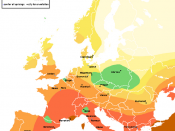Bubonic Plague, commonly known as Black Death is a disease carried by rats and transmitted by fleas. People infected would either suffer from great swelling, or die quickly, before any obvious symptoms appears, or die after suffering from symptoms such as a sudden fever that turns their face a dark rose color, and a sudden attack of sneezing, followed by coughing up blood. However, in the late 1340s, an epidemic of Black Death broke out in Europe. In the next few years, the disease killed off a massive portion of Europe's population. Eventually the plague did disappear, but it left Europe with great cultural changes. Immense effects could be seen in culture, spirituality, and especially economics.
Normal people were tormented by the threat of death, causing people to change their views on leisure and art. In art, the changes were extreme. During the pre-plague times noble lords were shown in full health, in their best clothes and armor, holding their swords.
Afterwards, half-decomposed bodies with parts of skeleton clearly visible were shown. The clothes draping the body were old dirty rags, and some sculptures showed worms and snails burrowing in the rotten flesh. Suffering became a favorite theme and it was a very cruel sort of art. Yet on the other hand, the plague benefited art. Death inspired artists to stray from religious pictorials. In architecture, many of those with the skill to build had been killed by the plague. Therefore less complicated techniques were used, leading to a decline in standards of European architecture at this time.
Change in spirituality was one of the major effects of the plague. The most common belief was that the plague had been sent by God and that it was his punishment for the sins humankind had committed. Some people who believed...


